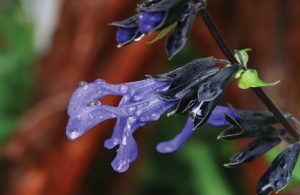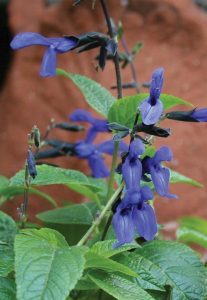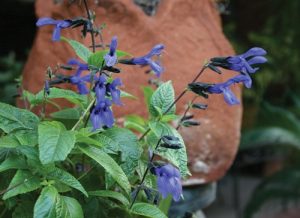SALLY BENSON MAY 31, 2017

It’s not often that I envy those who live in warmer climes. No disrespect intended, but as a dyed-in-the-wool fan of winter, I’d rather spend my time in the snowy mountains than on sunny beaches. On the other hand, I’d give up nearly all my sweaters and boots to be able to grow Salvia guaranitica ‘Black and Blue’ as a perennial. I do grow it; residing in Zone 5, I have to settle for potting up container after container of annual sage. Nevertheless, it’s among the first plants I look for each spring, and there are several designated planters that wait patiently every year for their new crop of Black and Blue.
Name: Salvia guaranitica ‘Black and Blue’
Common name: Black and Blue sage, anise-scented sage
Hardiness: Zones (7)8 to 10
Mature height: 2 to 5 feet
Mature spread: 2 to 5 feet
Classification: Tender herbaceous perennial or subshrub; grown as an annual in cooler zones
Landscape use: Borders, mixed beds, cutting gardens, containers
Ornamental characteristics: Clear, medium to dark green leaves emerge from deep, very dark green to purple to black stems; two-lipped, tubular, deep cobalt-blue flowers are supported by nearly black calyxes
If you’re fortunate enough to grow in zones 7(8) to 10, you know the joy of siting this perennial sage in borders or in cutting gardens, and when planted en masse, it can come to resemble a small shrub or hedge. It’s a fast-growing plant, reaching 3 to 4 feet tall and wide in a rounded, clump form, although some very happy plants can reach up to 5 or even 6 feet tall. Grown as an annual, in containers, mine tend to top out at 2 to 2.5 feet, although when the pot is large enough, a few have grown to 3 feet. Without the support of fellow plants, they benefit from slender plant hoops that are quickly camouflaged by the foliage – although in the years that I’ve forgotten to insert the supports, the plants do just fine.
Salvia can be grown from seed, but ‘Black and Blue’ is best propagated from cuttings, and I’ve relied on starter plants, which thrive on the sunny front steps. (There are a few plants on the shady north side of the house, and these perform admirably, although some of the stems tend to overreach if they don’t receive a few hours of direct sun.) It doesn’t take long before the foliage elongates to about 2 to 3 inches and the stems darken; by early to mid-summer, the black calyxes develop and stop-you-in-your-tracks, cobalt-blue flowers emerge.

This is when Black and Blue salvia truly shines. Individual flowers are large, reaching nearly 2 inches from stem to tip, and while they resemble the typical, tubular, two-lipped salvia flower, their dramatic color and size put them in a class by themselves. (One neighbor commented that she’d never seen a blue snapdragon. She still hasn’t.) Bloom is reliable until frost. Deadheading tends to encourage new blooms, but the only time I’ve “deadheaded” is when I’ve selected a few stems to use in a vase. More often than not, though, I leave the flowers for the pollinators.
Bees will visit and butterflies love the plant, but this salvia has proved to be irresistible to the local hummingbird population. It’s not unusual to see the plants waving with activity, and often, when the windows are thrown open in the summer, I can hear the deep buzz from my seat inside the house. Several hummingbird feeders are nearby, and these are routinely drained and cleaned, then refilled, then drained and cleaned … as long as the Black and Blue is in bloom. I’ve learned to leave shallow dishes of water for the exhausted little hummers, because it seems they can’t tear themselves away from the blooms. Neither can I.

In warmer zones, where the plants are perennial, they suffer from few insect or disease problems, although the occasional visit by downy and/or powdery mildew has occurred. Friends in Austin, Texas, say it’s among the cleanest plants they grow; that observation is echoed by friends in New Mexico. More humid microclimates would encourage mildew, but heat and humidity in the Chicago area can be wicked. Even when I’ve crowded containers so that the plants have tended to intertwine, they’ve remained healthy all season.
Inground or in containers, Salvia guaranitica ‘Black and Blue’ consistently provides breathtaking blue blooms and a feast for hummingbirds and other pollinators. Easy to grow and easy to maintain, it’s a must-have if you want to stop traffic, both human and avian.